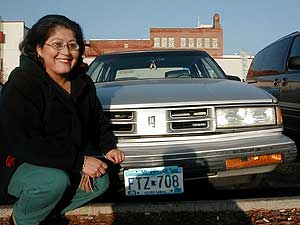|
Audio
Photos
More from MPR
Resources
Your Voice
|
Working to drive
January 27, 2003
 |
| Kari Jones loves her silver Oldsmobile, which she bought nine months ago with the help of a special program that assists low-income people with car payments. (MPR Photo/Mark Steil) |
Mankato, Minn. — When Kari Jones gets behind the wheel of her car, she reflects on how much her life has changed in the last few years. She was on welfare, now she has a job.
"Before the welfare reform took place, I have to tell you that I was so dependent on the system that I was actually afraid," she says. "I was really scared of getting out there and working."
She overcame the fear, found work, and has held the same job the last four years. She's employed as a clerk for the Minnesota Valley Action Council. One advantage she had in looking for work, compared to many welfare recipients, is that she had a car. She used her ex-husband's vehicle. But last year he took the car back.
"Where I live is about a mile from my job, so I could walk to work," she says. "But getting to my appointments, it would have been a real challenge. We go to individual therapy, family therapy, the boys wear glasses, we see dentists -- I mean clinic visits, everything. You definitely need a car."
 | |||
Jones was lucky her job was relatively close. She managed to get to work after she lost the car. Many people are not so lucky. In rural Minnesota, the loss of a car can easily mean the loss of a job.
After three weeks without a vehicle, Jones found help. Her employer, Minnesota Valley Action Council, had a program to help low-income people buy cars. Jones makes about $18,000 a year. She received $3,500 from the program -- half was a grant, the other half a loan. Jones used the money to buy what she calls "a smooth ride."
"We're looking at my great car," she says, showing off her vehicle. "My 1990 Oldsmobile 88, which I've had for about nine months. And I just love the car, I love it."
America loves the car. Most cities and towns are planned on the assumption that every resident has one. Businesses, schools and other employers are often on the edge of town.
"We are a culture highly dependent on our vehicles," says Greg Owen, who works for the Wilder Research Center in St. Paul. Several years ago he helped write a report which looked at problems people face in moving from welfare to work. One of the biggest was transportation.
 | |||
"Having a reliable vehicle means that you are more likely to be employed," says Owen. "That's one of the few pretty steady and reliable generalizations from the welfare reform research that's been done to date."
But achieving the potent mix of a job and a car can be difficult. Many people describe it as a catch-22 -- they need a car to hold a job, but they need a job to buy a car.
Enter the McKnight Foundation. It donated $20 million in the late 1990s to local agencies to help people find and keep jobs. Some of the McKnight dollars were used to help people buy vehicles. One agency even became a licensed car dealer. But most started a loan program to help job hunters buy reliable transportation.
Many of the programs have ended, but a few are still operating. One is in southwest Minnesota. Mary Mulder oversees the six-year-old program. She says its helps people buy cheap, but reliable, vehicles.
"It was a $2,000 loan and basically low interest," she says. "And what it ending up being was a car payment of about $69 a month."
Mulder works for the Southwest Private Industry Council. She says limited public transportation and long distances to jobs made southwest Minnesota an ideal testing ground for a car-buying program. She gives the program mostly positive grades, saying it's helped many people.
One thing which surprised her was how much work her staff puts in. They scrutinize everything from a person's financial records to the cars themselves. Then they have to collect the monthly loan payments -- and offer advice on mechanical problems.
"Myself and the job counselors can all attest to (some basic knowledge of) rotors and brakes and brake pads and cylinders," Mulder says. "We know more about cars then we ever thought we would."
There are other difficulties. Even though the loans are cheap, only about half the people pay the money back. Some leave the state. One vehicle ended up in a Sioux Falls impoundment lot. Mulder got the car out, and then had to find another buyer.
"It sat at one of my job counselor's houses for a while, until they didn't want it at their house anymore," says Mulder. "So then it came to the parking lot at the work force center, and we were able to find a customer that needed a vehicle."
But even with the problems, Mulder says there's no doubt the program is valuable. Helping someone find and keep a job is only the most obvious payoff. The car program also works at a deeper level.
Unless it's voluntary, being without a car in America generally deflates a person's sense of self worth. Mulder says her clients experience the feeling every time they ask someone for a ride. But that changes when they own a car.
"Self esteem doubles or triples because of having a vehicle," Mulder says. "And I think kids feel better when mom and dad can pick them up at school, or go to parent teacher conferences, because they have a vehicle." Along with the ego boost come other benefits. A person's credit rating goes up if they make all the payments. They learn about car repairs -- how to change oil, spark plugs and brake pads.
But cars have costs too, things like insurance, parking fees and fuel. Mulder, though, believes the benefits outweigh the extra expenses.
"I think that a lot of the folks that we're working with here need a car," Mulder says. "Not only to get back and forth to work, but they need a car to just keep their families afloat."
And that's what Kari Jones of Mankato discovered about her car. It helps her get by.
"I don't feel like I live in poverty," Jones says. "But because I never have anything extra, never have anything saved, barely making ends meet -- I feel like I'm the working poor."
But there are good things in her life too. Her kids, her job -- and her silver Oldsmobile.
|
News Headlines
|
Related Subjects
|

